EVALUATING LIMITS OF LIMITS FROM GRAPH
Subscribe to our ▶️ YouTube channel 🔴 for the latest videos, updates, and tips.
Give the value of each statement. If the value does not exist, write "does not exist" or "undefined".
Evaluate the following from the graph given below.
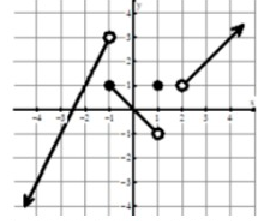
Problem 1 :
lim x→−1- f(x)
Solution :
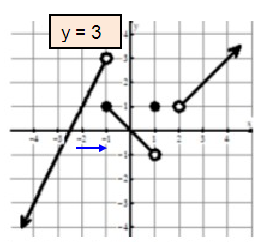
Approaching -1 from left side, we get the value of y as 3. So,
lim x→-1- f(x) = 3
Problem 2 :
f(1)
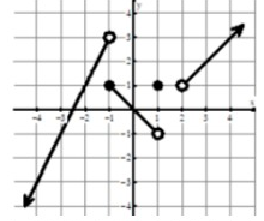
Solution :
We see the filled circle at (1, 1). So, the value of f(1) is 1.
Problem 3 :
lim x→0 f(x)

Solution :
At exactly x approaches 0, the output is 0.
lim x→0 f(x) = 0.
Problem 4 :
lim x→2+ f(x)

Solution :
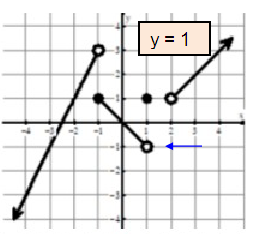
Approaching 2 from right side, the output is 1.
So, lim x→2+ f(x) = 1
Problem 5 :
f(-1)
Solution :
We see the filled circle at (-1, 1). So, the value of f(-1) is 1.
Problem 6 :
f(2)
Solution :
f(2) = does not exists.
Problem 7 :
lim x→−1+ f(x)
Solution :
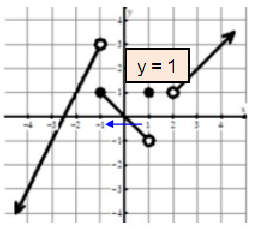
Approaching -1 from right side, we get the value of y as 1. So,
lim x→-1+ f(x) = 1
Problem 8 :
lim x→1- f(x)
Solution :
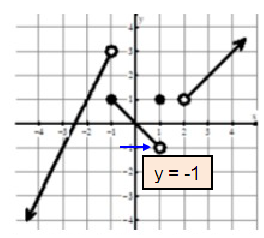
Approaching 1 from left side, we get the value of y as -1. So,
lim x→1- f(x) = -1
Problem 9 :
lim x→2 f(x)
Solution :
Both left hand and right hand limits are not equal, the limit does not exists at x = 2.
lim x→2 f(x) = DNE
Evaluate the following from the graph given below.
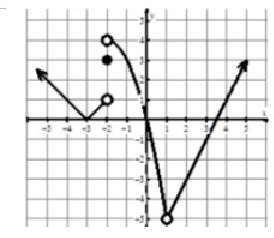
Problem 1 :
lim x→-3 f(x)
Solution :
lim x →-3 f(x)
At x = -3, the curve touches the x-axis. So, the output is 0.
lim x →-3 f(x) = 0
Problem 2 :
f(1)

Solution :
The point f(1) does not pass through any points. So, the answer is does not exists.
Problem 3 :
lim x→1 f(x)

Solution :
Left hand limits are not equal. Then right hand limit is exists at x = 1.
lim x→1 f(x) = -5
Problem 4 :
lim x→-2+ f(x)

Solution :
Approaching -2 from right side, we get the value of y as 4. So,
lim x→-2+ f(x) = 4
Problem 5 :
f(3)
Solution :
The curve passes through the point (3, -1).
f(3) = -1
Problem 6 :
lim x→-2-f(x)
Solution :
Approaching -2 from left side, we get the value of y as 1. So,
lim x →-2- f(x) = 1
Problem 7 :
lim x→-2 f(x)
Solution :
Both left hand and right hand limits are not equal, the limit does not exists at x = -2.
lim x→-2 f(x) = DNE
Problem 8 :
f(-2)
Solution :
We see the filled circle at (-2, 3). So, the value of f(-2) is 3.
Problem 9 :
f(4)
Solution :
The curve passes through the point (4, 1), so the value of f(4) is 1.
Evaluate the following from the graph given below.
Problem 1 :
lim x→3+ f(x)
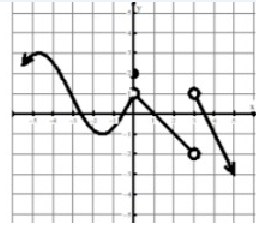
Solution :
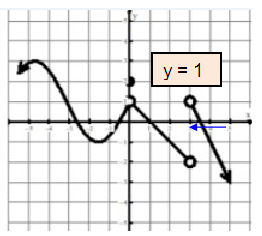
Approaching 3 from right side, we get the value of y as 1. So,
lim x→3+ f(x) = 1
Problem 2 :
f(3)
Solution :
The curve does not pass through any points on the y-axis. So, the answer is does not exists.
Problem 3 :
lim x→0 f(x)

Solution :
At exactly x approaches 0, the output is 1.
lim x→0 f(x) = 1.
Problem 4 :
lim x→3 f(x)

Solution :
Both left hand and right hand limits are not equal, the limit does not exists at x = 3.
lim x→3 f(x) = DNE
Problem 5 :
f(0)
Solution :
The curve is passing through (0, 2). So, the value of f(0) is 2.
Problem 6 :
lim x→3- f(x)

Solution :
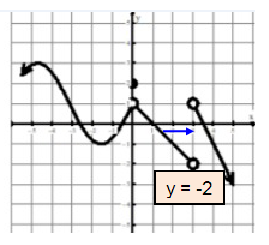
Approaching 3 from right side, we get the value of y as -2. So,
lim x→3- f(x) = -2
Problem 7 :
lim x→0+ f(x)
Solution :
While approaching the value 0 from left side, the output becomes 1.
So, lim x→0+ f(x) = 1.
Problem 8 :
f(1)
Solution :
The curve is passing through (1, 0). So, the value of f(1) is 0.
Subscribe to our ▶️ YouTube channel 🔴 for the latest videos, updates, and tips.
Recent Articles
-
Finding Range of Values Inequality Problems
May 21, 24 08:51 PM
Finding Range of Values Inequality Problems -
Solving Two Step Inequality Word Problems
May 21, 24 08:51 AM
Solving Two Step Inequality Word Problems -
Exponential Function Context and Data Modeling
May 20, 24 10:45 PM
Exponential Function Context and Data Modeling